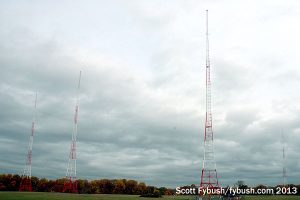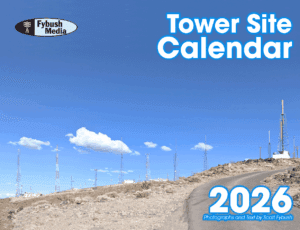Site of the Week 4/4/2025: From the Poconos to Scranton
A visit to many of the sites in Pennsylvania's Poconos, plus Bold Gold's stations in Scranton
(This week’s Site of the Week originally appeared Feb. 13, 2015. We’re reprising it this week because the wrecking ball is now swinging at the transmitter building for WMAL that we visited in late 2013. For the moment, WMAL is still using these towers, with its transmitter and phasor tucked away in a container on the grounds; it has a construction permit pending to diplex on the WSPZ 570 site in Germantown, a dozen miles or so northwest of this site.)
Text and photos by SCOTT FYBUSH
It’s been all over the headlines in the industry trades the last few days: Cumulus has put the transmitter site of WMAL (630) in Montgomery County, Maryland up for sale at a price that’s likely to exceed $100 million, an order of magnitude higher than what the signal itself is probably worth in today’s economy.
But while the actual listing with a broker (bids are due March 12) is fresh news, it was no secret at all that the land was headed for sale when we were last in Washington in November 2013. And that’s why we made it a point to stop in for a tour of WMAL’s transmitter site – and its studios, too.
The studios, first: it was the summer of 1973 when the Washington Star moved the studios of WMAL and its sister station WRQX (107.3) into new digs on the top floor of an office building at 4400 Jenifer Street NW, just a block from the District-Maryland line in what’s now an upscale shopping district.
In its current form, several renovations later, this plant feels a little more “radio station” than your typical 21st century cluster studio. Get off the elevator, go through the lobby, and a main hallway looks into the main air studios of WRQX on one end and WMAL on the other.
That’s the main WMAL talk studio and the adjoining control room shown just above, and there’s live talk coming out of here for a big chunk of the day, though its hard political edge is a far cry from the sort of full-service, friendly talk that this studio’s original occupants, Frank Harden and Jackson Weaver, offered up for many decades.
WMAL’s FM sister, WRQX, has been through a few incarnations in recent years; after a long run with rock as “Q107” and then a softer sound as “Mix 107,” it was “All the Hits 107-3” when we stopped by, a top-40 incarnation that’s since morphed into “DC’s 107.3.” (And how can you not love that beautiful PR&E console that still had pride of place in the control room?)
There’s a spacious rack room/tech center behind this row of studios, and it leads out in turn into a newsroom that looks out the back of the building over the big Lord & Taylor next door.
Since 2011, WMAL has been simulcast on WMAL-FM (105.9 Woodbridge VA), the latest incarnation of a suburban FM signal that was smooth jazz WJZW when it joined this cluster under ABC/Disney ownership in 1997.
The jazz gave way to True Oldies Channel, then to classic rock as WVRX (“105.9 the Edge”) before the WMAL simulcast began; today, the old 105.9 studio is a production room adjoining the newsroom, one of several production suites in the complex.
But we didn’t really come all this way just to see studios. We wanted to get a look inside the AM 630 transmitter plant while it was still there to be seen, and WMAL engineers (and history buffs) Dave Sproul and Mike Benonis were very happy to show it off – so much so that ours was one of several tours that passed through this site alongside the Beltway in Bethesda in the fall of 2013.
Here’s the part where we dig deep into history: WMAL is Washington’s third-oldest station, behind 1923 arrival WRC (later WTEM) and WOL, which dates to 1924. (Thomas White has detailed the early history of the market here.)

The WMAL calls come from optician M.A. Leese, who put the station on the air from his 11th Street NW shop. Leese turned his attention from glasses completely to radio, and his station grew quickly, becoming the market’s CBS affiliate in 1928 and then joining NBC’s Blue network in 1932. NBC leased WMAL soon afterward, operating the station in tandem with Red outlet WRC until such duopolies were outlawed in 1943, at which point operation passed to the Star, which had acquired the station from Leese.
By then, WMAL had moved its transmitter from the roof of its studios in the Trans-Lux Building on 12th Street NW out to what were then the wide-open spaces of Montgomery County, north of the city, where it built a four-tower directional array on what was then a 100-acre parcel along Greentree Road. (The official sign-on date out here was February 24, 1941, just a month before most US broadcasters changed frequency under the NARBA treaty; WMAL was low enough on the dial that it was the one Washington station to stay put.)
Its TV sister WMAL-TV (Channel 7) debuted in 1947, and its need for space pushed the WMAL radio studios out here to the Colonial-style transmitter building until the Star was able to complete a new radio-TV studio center in a former ice rink on Connecticut Avenue NW in 1956. Even that didn’t last long; in 1961, the need for more TV space in the city once again pushed the radio studios out here to Greentree Road, where they remained until the move to Jenifer Street in 1973.
In the four decades since then, time sort of stood still out here at the transmitter site, which has slowly turned into a combination of storage space and a well-preserved museum of 1960s-era broadcasting. Come in the front door and a vestibule opens into a high-ceilinged transmitter room decorated with memorabilia that includes several portraits of Harden and Weaver. The transmitters here are fairly new: a pair of Harris DX10s used in an alternate-main configuration.
There’s a control rack and an engineering office at one end – and at the other end, a pair of unassuming doors lead back into the studio area that WMAL used in its glory days out here.
That’s Harden and Weaver’s studio clock on the table below, and several shelves full of vintage processing, meters, remote gear and other goodies right next to it. A narrow hallway adjoining this studio is where the news teletypes once sat – and yes, it was out here that WMAL reported the news of the Kennedy assassination and the moon landing, among other big events.
One room out here was used by WMAL-TV when it began installing satellite downlinks that it then microwaved back to its studios in the city. Even after the radio and TV stations went to separate owners – channel 7 is now WJLA for Joseph L. Allbritton, who bought the Star and the TV holdings in the 1970s – the TV side continued to rent space out here.
During WMAL’s decade-plus of studio operation out here, one big thing changed: WMAL-FM (107.3) went from a simulcast of the AM to doing its own thing as “The Soft Explosion,” with a somewhat strained split existence that found its programmers out here in Maryland and its studio at the TV studios in the District.
There are still some remnants of the FM operation down in the basement, where a portion of what had been purely utilitarian space was converted into programming offices for both AM and FM. Check out those murals of Washington landmarks that still survive on one of the basement office walls!
And that, for now, is where we leave WMAL, awaiting an uncertain next chapter. The 75 acres on which this site now sits are both a prime development parcel and a rare piece of green space in a neighborhood that was unimaginable when this site was built. The surrounding neighborhoods boast million-dollar homes and million-dollar incomes, and their occupants have long made use of this site (with WMAL’s tacit approval) as a dog park and walking space.
Once the inevitable happens, there will probably be some 300 new McMansions on this land – and a lesser 630 signal coming from somewhere else. This site’s chief protections are to WPRO in Providence (another Cumulus signal), to the former KXOK in St. Louis and to Cuba, which pretty much dictate a site north-northwest of the city. Where will WMAL end up, and what other AMs are under similar development pressure? We’ll be watching closely.
Thanks to WMAL’s Dave Sproul (ret.) and Mike Benonis for the tours!

As we announced a few weeks ago, the 2026 edition of the Tower Site Calendar will be the last.
We began publishing it 25 years ago, and the broadcast landscape is radically different now.
Radio World just ran an excellent article about us if you want to know more.
Once it’s gone, that’s it. We won’t be printing any more.
Thank you to everyone who saw our announcement and rushed to buy it. We appreciate you.
(There are some calendars from previous years if you want more of a tower photo fix — all under $5.)
But don’t wait to get this year’s Tower Site Calendar — buy it now!
We are selling the Broadcast Historian’s Calendar again this year, but we have that in an even smaller quantity — definitely don’t hesitate for that.
And visit the Fybush Media Store to check out our selection of books and videos, too!
Next week: Norfolk, Virginia
A visit to many of the sites in Pennsylvania's Poconos, plus Bold Gold's stations in Scranton
Tower Site goes Jeeping (and fixing a flat tire!) up in the mountains of northwest New Jersey
A look at two of the Voice of America facilities that were abruptly shuttered this month
Up in the hills and down in the valleys of north central Pennsylvania, checking out some small signals in small towns